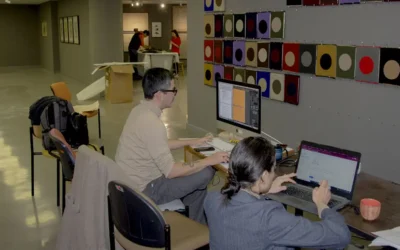Ray Harryhausen | Titan of Cinema: How the Archives Enrich Virtual Exhibit Storytelling

Rachael Cristine Woody
This is the third of four posts in the Ray Harryhausen | Titan of Cinema Virtual Exhibition Experience. In an earlier post we covered the translation from physical to virtual, and this week we’re evaluating how the Harryhausen exhibit used archival materials to enrich the virtual exhibit’s storytelling.
The Intersection of Archival and Museum Items
The Intersection of archives and museums is something I’ve written about previously. In this post we’re focusing on the differences that exist when displaying archival materials with museum objects in a physical vs virtual setting, and will use the Harryhausen virtual exhibition as our example.
The Role of Archival Materials in an Exhibit
When we think about the museum object and its role in an exhibit, we know that it can serve as a point of knowledge, curiosity, or engagement. It’s something to be viewed and sometimes touched, and the information the object conveys is strictly non-verbal. With archival materials the information is almost entirely conveyed with written or spoken words. (Photographs are a notable exception). Archival materials are not usually splashy, they’re not the blockbuster objects, and yet the information they contain can be extensive. Items from the archives are usually used to provided better contextual information for a person, place, event, or thing. They’re supporting, supplementary information vehicles that curators may or may not think to include in the exhibit.
Archival Materials in the Ray Harryhausen | Titan of Cinema Virtual Exhibition Experience
When you remove the 3D objects from the Harryhausen exhibit you’re still left with a wealth of materials to view—materials that are classified as more archival in nature. There are:
- Five specially created films that explore different facets of Harryhausen’s career
- Footage from Harryhausen’s life and work
- Diary entries, movie posters and paraphernalia, photographs, and sketches
Each section has video at the top of the page that serves as an introductory exhibit panel. After watching the video viewers can then visit several carousels of items where the majority of the archival material is housed. Grouped around subject matter, the viewer can explore a variety of archival material formats within each carousel; which helps to keep the viewer engaged.
How Archival Materials Can Thrive in a Virtual Exhibition
A virtual exhibition can level the playing field and democratize exhibit display between museum objects and items from the archives. When in-person 3D items can more easily attract your attention while the archival material is usually 2D and lying flat in a case. But in a virtual space archival materials are displayed in the same way as 3D objects. With this in mind, I have a few recommendations for how you can create a virtual space where these archival items will thrive.
Recommendations:
- Be conscious of how much text you provide next to an archival item, especially if the item itself contains text.
- In a few sentences, explain to the viewer why this item was included. What additional information or meaning does it add to exhibition?
- Provide a dynamic viewer so that the archival item can be seen in detail and read (if there is readable text).
- Make sure to offer captioning, a transcript, translations, alt-text, etc., so that all viewers can comprehend and enjoy the content.
- With a virtual space it’s easy to include a lot of items. However, keep in mind that viewers may not want to view all the items nor read all the exhibit labels. To account for this, offer a “quick view” when the mouse hovers over the item so the viewer can quickly determine if it’s an item they want to investigate further.
- Make it easy to navigate between items by limiting the number of clicking in and out of viewers and instead offer navigation arrows to move through items within the viewer.
Conclusion
Essentially, what it comes down to is digital usership-based design combined with online best practices. With a thoughtful approach and a flexible exhibit platform, archival materials can be delivered to viewers in an engaging way. Tune in next week for the fourth and final post in this mini-series: Ray Harryhausen | Titan of Cinema: Reminiscing with Fantastical Creatures from Childhood.

Rachael Cristine Woody
Expert, consultant and blogger Rachael Cristine Woody advises on museum strategies, collections management, digital museums, and grant writing for a wide variety of clients. She is a popular presenter and Lucidea Press author. For more on museum success, learn about Lucidea’s Argus Museum CMS for virtual, multimedia presentation of collections, visitor engagement, and museum staff productivity and impact.
Similar Posts
How to Incorporate Interns in Museum CMS Projects: Data Creation
A museum expert details how interns can be successfully included in museum CMS projects at the data creation stage.
How to Incorporate Interns in Museum CMS Projects: Data Capture
A museum expert highlights how interns can be included in museum CMS projects at the data capture stage
How to Incorporate Interns in Museum CMS Projects
A museum expert highlights how interns can be included in museum CMS projects with three project ideas.
Create a Start-to-Finish Process for Cataloging Objects in the Museum CMS
A museum expert outlines the start-to-finish process for cataloging objects into a new museum CMS.
Hosting service
Enjoy all of the benefits of your Lucidea solution with secure, reliable, stress free hosting
Programs & incentives
No matter your size or budget, we’ve got you covered, today and tomorrow




Leave a Comment
Comments are reviewed and must adhere to our comments policy.
0 Comments